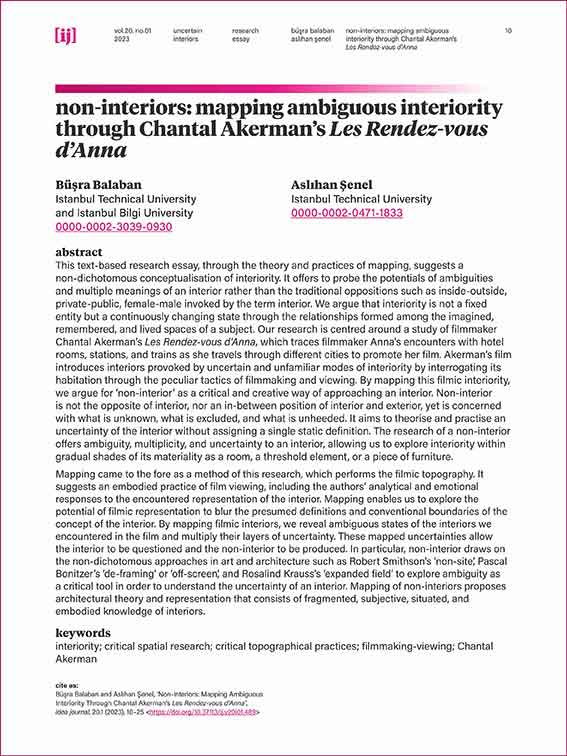Non-Interiors Mapping Ambiguous Interiority Through Chantal Akerman’s Les Rendez-vous d’Anna
Main Article Content
Abstract
This text-based research essay, through the theory and practices of mapping, suggests a non-dichotomous conceptualisation of interiority. It offers to probe the potentials of ambiguities and multiple meanings of an interior rather than the traditional oppositions such as inside-outside, private-public, female-male invoked by the term interior. We argue that interiority is not a fixed entity but a continuously changing state through the relationships formed among the imagined, remembered, and lived spaces of a subject. Our research is centred around a study of filmmaker Chantal Akerman’s Les Rendez-vous d'Anna, which traces filmmaker Anna's encounters with hotel rooms, stations, and trains as she travels through different cities to promote her film. Akerman’s film introduces interiors provoked by uncertain and unfamiliar modes of interiority by interrogating its habitation through the peculiar tactics of filmmaking and viewing. By mapping this filmic interiority, we argue for ‘non-interior’ as a critical and creative way of approaching an interior. Non-interior is not the opposite of interior, nor an in-between position of interior and exterior, yet is concerned with what is unknown, what is excluded, and what is unheeded. It aims to theorise and practise an uncertainty of the interior without assigning a single static definition. The research of a non-interior offers ambiguity, multiplicity, and uncertainty to an interior, allowing us to explore interiority within gradual shades of its materiality as a room, a threshold element, or a piece of furniture.
Mapping came to the fore as a method of this research, which performs the filmic topography. It suggests an embodied practice of film viewing, including the authors’ analytical and emotional responses to the encountered representation of the interior. Mapping enables us to explore the potential of filmic representation to blur the presumed definitions and conventional boundaries of the concept of the interior. By mapping filmic interiors, we reveal ambiguous states of the interiors we encountered in the film and multiply their layers of uncertainty. These mapped uncertainties allow the interior to be questioned and the non-interior to be produced. In particular, non-interior draws on the non-dichotomous approaches in art and architecture such as Robert Smithson's ‘non-site’, Pascal Bonitzer’s ‘de-framing’ or ‘off-screen’, and Rosalind Krauss's ‘expanded field’ to explore ambiguity as a critical tool in order to understand the uncertainty of an interior. Mapping of non-interiors proposes architectural theory and representation that consists of fragmented, subjective, situated, and embodied knowledge of interiors.
Article Details
Author/s and or their institutions retain copyright ownership over works submitted to Idea Journal, and provide the Interior Design / Interior Architecture Educators Association with a non–exclusive license to use the work for the purposes listed below:
- Make available/publish electronically on the Idea Journal website
- Publish as part of Idea Journal's online open access publications
- Store in electronic databases, on websites and CDs/DVDs, which comprise of post-publication articles to be used for publishing by the Interior Design / Interior Architecture Educators Association.
Reproduction is prohibited without written permission of the publisher, the author/s or their nominated university. The work submitted for review should not have been published or be in the process of being reviewed by another publisher. Authors should ensure that any images used in their essays have copyright clearance.

